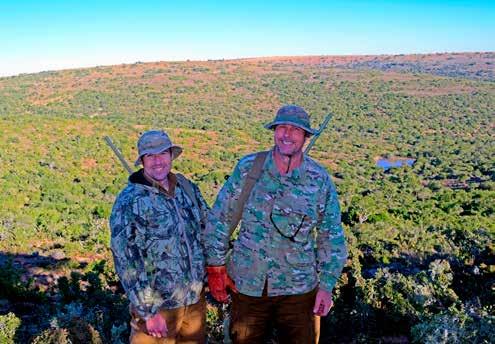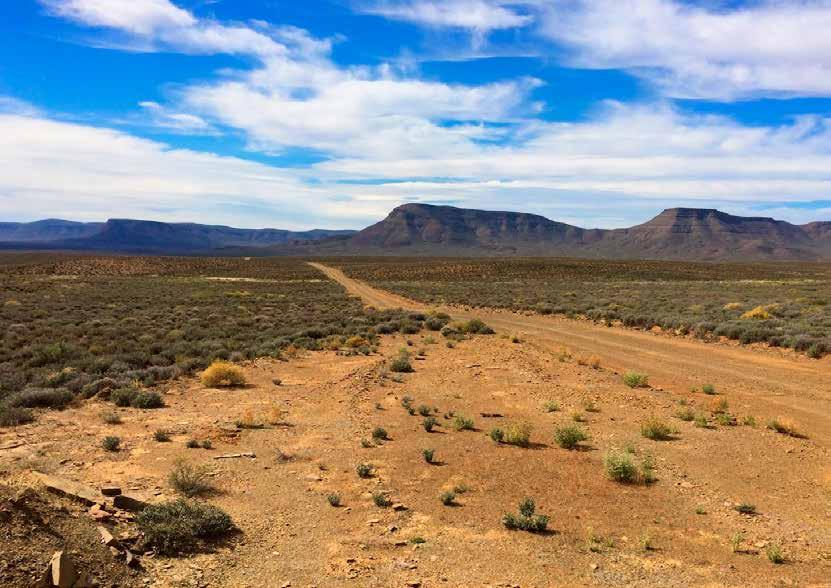
18 minute read
HUNTING IN THE VALLEY BUSHVELD
by Die Bontebok
Sunset over the Eastern Cape bushveld HUNTING IN THE VALLEY BUSHVELD
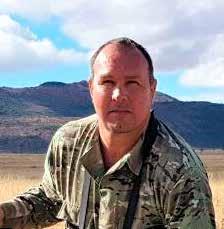
Advertisement
By Greg Sykes
The 24th of July just could not roll around fast enough. Our hunting was late this year as normally on the 1st of May we find ourselves in the veld already. Eventually, after what felt like an eternity, the day arrived and with the trailer hooked on and a full load of eager hunters, we pointed the old Toyota eastward. It is a long trek to the Eastern Cape, but the anticipation of spending time out in the bush shortened the road and as the kilometres drained away our excitement began to increase. Western Cape hunters really have to travel far and wide for good hunting opportunities. Realisticly the closest being 500km and really good terrain being as far as 900km away. Our destination was Bowden farm, owned by Pete Dugmore. Bowden is an original 1820 settler farm that has been in the same family since those long gone frontier days. Bowden sits above the Great Fish River Valley with parts of the farm dropping off towards the river but never actually reaching it. The terrain is typical Eastern Cape valley bushveld with an abundance of “spekboom” (Portulacaria afra) which is the Kudu’s favourite feed. There are open plains at the top of the valleys that spread out into grassy plateau’s. The springbok and black Wildebeest speckle these plains and offer challenging stalking for those prepared to put in the effort to worm your way across the open areas.
Since Ludy Starke, Wesley White and myself had only arrived in the afternoon, we decided to first stop in Graaff-Reinet, spend the night there and be off to a predawn start the next day. We hoped to be able to arrive on the farm early, sight in the guns and still get in an afternoon’s hunting. Tony Robinson and his son Steve would join us a day later. To avoid the tedium of the 140km arrow straight road between Beaufort West and Aberdeen, we took the Nelspoort road to Murraysburg. The road eventually brought us to the back end of GraaffReinet. The road is a dirt road, but is well maintained and has a lot of game farms along the way. This always makes the road shorter as your attention is drawn to the veld to see what can be spotted. If you reach Graaff-Reinet early enough and you drive past the entrance to the Camdeboo National park, it is well worth the detour to drive up to the top of the mountain and walk along the cliffs that make up the Valley of Desolation. We arrived on the farm nice and early the next morning as expected and after the traditional pleasantries and a compulsory cup of coffee, we went to check on our equipment. We have the rule that we check hunting equipment before we shoot at animals, whilst we are ultra careful with the rifles to make sure we are properly zeroed in the Cape. One never knows what road Gremlins can creep in and shift the scope settings. All was good on the range and we left for an afternoon walkabout. The afternoon did not produce any animals but I can’t say that the time spent in the bush was unproductive. City eyes started to adapt, and stupid feet started to find the natural
rhythm of walking over the uneven terrain. I have hunted on Bowden farm for the past 20 years. Initially I was the young invited guest to a hunt arranged by the late Derek Ramsay. The farm was a handy half way point so that old hunting friends from the Western cape and Natal could join up once a year for their hunt. I was the apprentice hunter and general skivvie for the old hands, but was an eager participant as the hunting lessons that the old guys handed out wase an invaluable education for me being the inexperienced hunter that I was at the time. Over time the old guard left one by one to take up their final voorsit spots and I inherited this great hunting spot.
That evening just as Wesley got the fire going and Ludy was chatting to the farm owner, Tony and Steven arrived. With our full compliment of eager nimrods now safely on the farm, the anticipation for the next morning was running high. Fire talk was of course centred around strategies to outwit the kudu and impala, plans were discussed to ensure that the different hunters would not wander into areas covered by other hunters and the do’s and dont’s were clarified with Pete. Due to my long standing relationship with Pete we have the privilege of being trusted enough to go out and hunt alone, something that only comes with years of trust that is guarded jealously. The sun was still an hour away from even making its first impression on the Eastern horizon when I woke to the sound of the kettle cheerfully singing on the gas stove. Wesley was up early and was making coffee, I pulled the blankets up under my chin to keep the predawn cold out of my bed and in my mind I played the various scenarios and plans of action for the days hunt. Wesley, the gentleman that he is, soon popped his head around the corner and placed a steaming mug of coffee and a rusk down next to my bed. “Time to move your ass old man” he laughingly chided me. By the time the sun began pushing the night sky away we were already out in the veld. Tony made his way up onto the plateau where he had seen a herd of impala feeding the previous day, while Ludy, Wesley, Stevenand myself headed out to the valley bushveld area. We split up at the top of the first valley, with Ludy heading west, Steven east and myself and Wesley hunting together going south. Due to the high hills and depth of the valleys, we could all safely hunt in our respective valleys as the mountains provide a perfect cut off zone between us. Before splitting up we had laid out the no-shoot zones and a plan should we hear shots from any of the other hunters. Wesly and myself walked slowly and quietly in a southerly direction about mid way up a hillside. We kept the gentle morning wind on our left cheeks as a guide to make sure we would not let our scent precede us and warn the animals ahead of us. We spent an hour advancing a few steps, stopping, standing still and glassing the opposite valley as well as the bush in front of us. We immersed ourselves into the bush which was really rewarding when we spotted a duiker ram feeding on a bush 40 metres in front of us. Our slow and quiet advance enabled us to see him before he spotted us and bolted. Had he done that, our game would have been u,p but instead we were able to sink down and wait until his natural feeding pattern took him up and out of our path. Once he was safely out of our way we continued the slow walk. Fifteen minutes later our patience was rewarded by a flash of white between the spekboom. It was a kudu calf. We eased our bodies down at a snails pace into a sitting position alongside the trunk of a wild olive tree and sat glassing the area where we had seen the calf. As our eyes adjusted we started to pick up more of the heard browsing amongst the spekboom with the morning sun
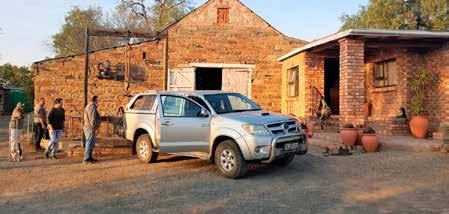
The ancient farmhouse next to the modern hunting lodge. The old building with the white doors used to be the postal agency for the district in times long ago

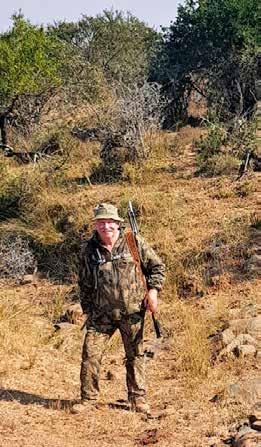
Tony in full hunting gear on the lookout for impala
catching an exposed spot of hide or horn tip every now and then, causing the owner to be exposed. I slowly eased myself out from under the tree and found a spot still in the shadow of the tree, but open enough to get a clear line of sight through the spekboom. My chosen spot of about one square meter just allowed me space enough to set up my shooting sticks. This was done at a pace that makes pouring cold honey look fast. I picked out a nice bull (not the heard patriarch) as we hunt for meat and I prefer a youngish bull as the meat is tender and not as gamey as that of the older bulls. The range finder reported a distance of 265 metres and with the bull walking slowly towards a thicket. I steadied the rifle in the sitting position using two of the legs of the sticks as a front and rear support. Once the cross hairs settled down at a point on the front of his chest, which I had reckoned would be the right spot to aim for to compensate for the fact that he was walking slowly and slightly away from us, I took a deep breath and broke the shot.
I have always been an advocate for the shooting sports as a realistic practice for hunting. The CHASA range shoots as well as the Veldskiet competitions really give the shooter a lot of practice from realistic hunting positions. The stress of competing is a close simulation to the adrenaline that builds up when one is about to take a shot on a live animal. This morning all the practice and competition as well as the hours spent practicing on the range culminated in that split second of the shot. As the echoes of the shot resounded from the far side valley wall and again bounced back in ever decreasing volume from the distant cliff faces, I was amazed at how the bush literally came alive with kudu. Cows and young bulls were running in all directions as my shot’s rude intrusion into the peaceful morning had the herd heading for safer grounds. Luckily I managed to keep my bull in the scope during the recoil phase of the shot and I watched him as he ran about 20 metres and stopped. I was about to reload in case I needed to make a follow-up shot when I saw him stumble and collapse out of view into a thicket of spekboom. After waiting for ten minutes for the bush to settle, I left Wesley to mark our shooting position and went through the valley floor climbing up to the point where I shot the bull. Before setting out, I made a mental note of terrain features that I would be able to use as a guide once in the thick bush of the valley floor. A cabbage tree 50 metres to the right, a small opening 20 metres left of where he was browsing, a small cliff face just above where I last saw him go down were all features that I locked into my memory so that I could find the right spot. I find that once you have dropped down in the tangled mess of bush in the depths of the valley floor, it is easy to get disorientated and the bush starts to be confusing. Having clear features makes it easy to reorientate yourself. On arriving where I estimated that my bull had collapsed when I took the shot, I did a quick scout around and picked up his deep imprints where he had jumped off on the shot, clearly showing in the dry dust of the well worn game trail. With my level of tracking ability one cannot be 100% sure that the tracks are thatb of your specific animal as all of the Kudu jumped away in fright. I followed the track in the direction that I had seen my Kudu run and with a sense of relief within about 10 meters I picked up a strong blood trail confirming that I was indeed on the correct track. 20 metres further I found the bull. For me it is very special to spend a few minutes alone with my quarry. It gives me time to quietly sit next to him and give him the respect he deserves after giving up his life to become my food. We do not use silencers on our rifles and I have never felt it has made the game wild, however I firmly believe that by staying in cover and waiting till the animals have settled down after a shot, only showing yourself once enough time has elapsed for the animals to not associate your presence with the sound of the shot, the animals do not become wild and edgy. This was bourn out by the fact that as I quietly sat there contemplating the life and death of my bull, the rest of the heard had settled back into their grazing not more than 500 metres away at the head of the valley. I signalled to Wesly that I had found the bull and while he made his way over to my location, I busied myself with the task of gutting my bull and dragging him under some shade to protect the meat from the warmth of the
winter sun. Wesly told me that he had heard the dull reverberation of a distant shot and by working out the direction from which it came, we surmised that Ludy had opened his account and had shot his first animal. Those that know Ludy will understand why I could be so confident that he had shot an animal, even though in his sixties, he is still one of the best marksmen that I have ever had the honour of knowing. With Springbok colours in both practical pistol and silhouette shooting and a world championship medal to his name, Ludy does not miss very often.
I took some mental bearings of where my Kudu was lying in the shade where I had dragged him and we set off to go find Ludy to help him with his recovery. After a steep climb over the mountain that intervened between our areas, we crested and in the distance could see Ludy making his way towards the valley floor below us. We met up at his beautiful kudu bull where it laid at the base of a Euphorbia tree. Ludi regaled us with a blow by blow account of how a heard of Kudu had been feeding on the opposite valley ridge line from where he was walking, how he instantly dropped 30 years of age and like a ninja stalking the shogun, he leopard crawled over to the very edge of a cliff to set up his trusty .280 Remington on the Harris bipod. Ludy, a master story teller, enthralled us with the story of how the old bull, a wily and devious warrior kept to the thickets and let the cows first go ahead in case of danger, the bull would follow only after being sure all was ok and would move fast across any open ground and back into thick cover. The bull was keeping in the thick bush, almost as if he knew that a shot was impossible if he kept in cover, but Ludy noticed a small gap in the bush about 50 metres in front of the bull and directly on the path that the bull was walking along. Setting up to ambush the bull, Ludy ranged the bush and made an adjustment to the scope to ensure a perfect trajectory over the 285m to the bush. He worked out that at the slow pace and at the measured distance, he would have to lead the bull by about 25cm to ensure that when the shot arrived it would find its mark. As the Bull appeared, Ludy lead him and broke the shot. The old bull fell in his tracks.
As with all large game hunting, once the shot has been made, the real work begins. We worked hard the rest of the day recovering the animals and getting them back to the cold storage room. That evening around the fire, sore muscles were relaxed by a little sweet wine and a tumbler of Scotlands finest export with just enough ice to not cause offence to the whiskey connoisseurs of the world. The full details of the day were told and retold to the rest of the group. Tony and Steven related the happenings of their day too.
We hunted hard for the next two days with each hunter being successful. On the evening of the second days hunting, Wesley and myself were trudging back to the farm house after a full day’s hunting in the valleys. The sun was about a hand above the horizon indicating an hour of good hunting light left. As we crossed the open grass plains, heading towards the bush at the bottom end of the open area, we caught sight of a movement in a thicket. The binoculars confirmed that there were three kudu standing quietly in the bush. The shooting sticks were set up in record time and Wesley made a super 210m shot from the standing position on the sticks. On the shot, his bull dropped in its tracks and two other bulls broke from the cover of the bush and as it sometimes happens, they ran directly towards us. As we could see that Wesley’s kudu was down and not moving, I decided that if the hunting gods gift you a kudu you cannot turn it down. As the bull approached us, its sixth sense must have told
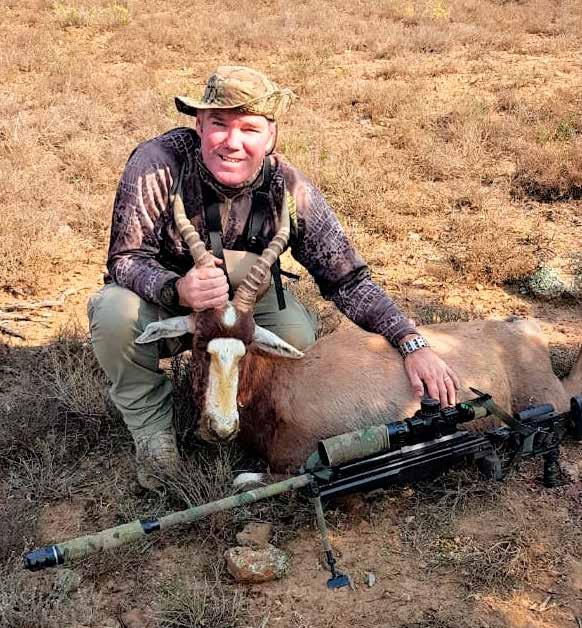
xxxxxxxxxxxxxxxxxxxxxxxxxxxxxxx Steve Robinson with his blesbok ram. Cleanly taken with his .260 Remington
it to stop, but unluckily for him, it was too late. The bull fell to a frontal shot from my trusty .308 and the Nosler Accubond bullet did its job. After a short dash he dropped. Two kudu bulls within 2 minutes. That’s a first for me.
On the last day of hunting, we had filled our allotted quota of Kudu so only Ludy, Tony and Steven went out hunting for impala and Blesbok while Wesley and I stayed in camp to skin and load the buck into the trailer. By the time Ludy returned with his final blesbok of the hunt, we were ready to head home. The final account of animals hunted was, myself with two kudu bulls, Wesley with a kudu bull and two springbok, Ludy shot a kudu bull, three blesbok and two springbok. Tony and his son both shot Kudu cows and Tony followed with an impala while Steven added a blesbok to his tally.
Leaving the farm is always sad as the memories of not only the hunting but also the special little surprises that Nature offers play through ones mind, the leguan down by the solar pump, the crowned hornbill that flitted from tree to tree in front of us while we were recovering one of the springbok, the fork tailed drongo darting down from his perch in a thorn tree to snatch up the unlucky fly that ventured too close to him or the cape fox that slinked away into the undergrowth as we came past the dam. These memories and experiences fill in the colour of the hunt and make the experience all the more rich. I always encourage hunters to immerse themselves in nature while hunting. Each new encounter with a previously unknown bird or insect adds spice to the overall experience. Even when a day’s hunting does not end in a downed animal, the joy of being part of nature as a player and not a spectator more than compensates for the lack of success. I would really encourage all hunters to get a few nature books and study up a bit on the flora and fauna in the area where you will be hunting. The Kaapjag dedicated hunter course also gives a world of useful information that enriches your hunting.
After sombre greeting to the farmer and the workers who helped out with the recovery, we reluctantly nudged the old Toyota towards the west. With a full load of meat and heavy hearts adding to the load together with the storm strength frontal winds that headed inland after ravishing the Cape, the fuel economy of the Toyota was a lot higher than anticipated and we nearly ran out of diesel halfway between Beaufort West and Aberdeen, you can’t find a more remote place in our vast Karoo, but as luck would have it we spotted a digger working about 300m off the road, we stopped and explained the situation to the operator who in typical fashion of the rural people of this country, went out of his way to find a pipe and siphon us 5 litres of diesel from his machine. Of course he didn’t want payment and we had to force him to accept the money. With this delay getting us into Beaufort later than planned, we decided to stay over instead of pushing through to the Cape. Terri Lemvelli just south of the town is a stunning place with nice chalets, sable, gemsbok, kudu and springbok, all peacefully feeding at the edge of the dam. Sanette who runs the establishment was at first a little cold towards us as hunters, but over the years as we stayed over, she had come to respect the part we play in nature and now warmly welcomes us and other hunters to break the long trip back with a relaxing stay over. She has a well stocked shop where all the necessities are available and if you are not in a rush, breakfast is available at the restaurant overlooking a water hole. With the hunting imperative now gone, one could really just sit and relax and enjoy the antics of the animals. Until next year when hunting season rolls around again, the biltong , droëewors and smell of nitro cellulose at the range will have to tide us over and keep the withdrawal symptoms at bay. What an honour and privilege it is to hunt in this great country.
